A merry festive season
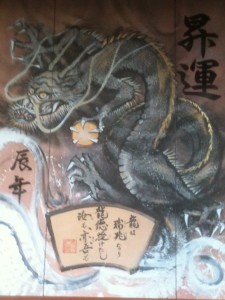
Get set for the year of the dragon
You could say that New Year is Japan’s equivalent to Christmas. It’s family-orientated, involves eating special food, and celebrates birth of a kind. The decorations feature an evergreen tree, and instead of midnight mass, there are midnight visits to a shrine.
At the heart of the Japanese New Year is the notion of renewal. In the Shinto view of life, the material world is subject to ‘pollution’ and depletion. Rituals of purification and shrine visits help bring about revitalisation. The desire for renewal is what lies behind the 20 year cycle of rebuilding at Ise; it’s what lies behind the cult of newness in Japanese culture as a whole. And that’s what the New Year is all about too – starting afresh.
Shuffling off the old
Getting ready for the New Year is serious business and takes up the end of December. The preparations involve, above all, osoji (big cleaning). The idea is that the home will be cleansed of negative energy and receptive to ancestral spirits. It’s the Japanese equivalent of spring cleaning – which originally it was, more or less. In 1873 Japan moved from the traditional Chinese-style calendar (based on the lunar cycle) to the Gregorian calendar, as a result of which the New Year moved from late January/ February to its present position.
The physical cleaning before New Year is matched by an emotional clean-out – wiping one’s mind clear of the debts and favours of the past year. This entails settling business accounts, mending relationships, offering thanks and tidying up personal affairs. There’s a sense of satisfaction in starting the New Year by having finished off the old one properly.
There are parties too ‘to forget the old year’ (bonenkai), usually with work colleagues. In these office parties, drunkenness washes away concerns about propriety and rank. Like Saturnalia, the conventions of everyday life are overturned in cathartic manner. Purged in this way, one is ready to truly start afresh.
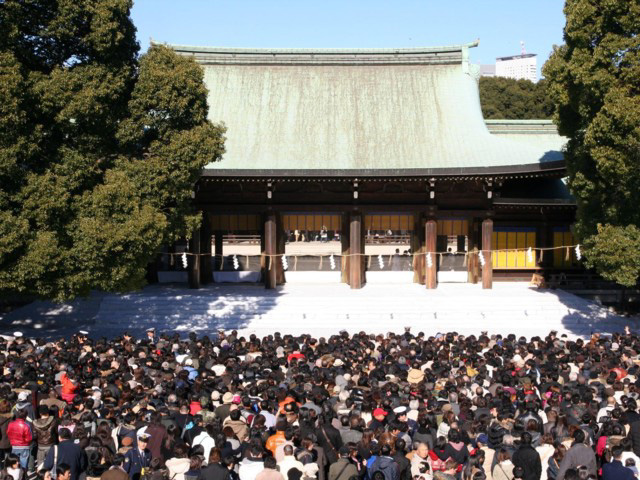
Move along please! Meiji Jingu at New Year is packed, so if you like being crushed this is the place for you....
Syncretic celebration
The way Shinto and Buddhism complement each other is never more clearly seen than on the night of Dec. 31. Buddhism is other-worldly, concerned with individual salvation. Shinto is this-worldly, concerned with rites of passage and social well-being. At New Year the two religions come together like yin and yang, either side of midnight. Buddhism sees out the death of the old; Shinto celebrates the birth of the new.
In the dying minutes of the year, people line up at a Buddhist temple to hear the bell riing, or to ring it themselves. By tradition it is rung 108 times, once for every attachment that plagues the human condition. The atmosphere is solemn, and in the darkness the booming of the large bell carries with it a mournful feel.
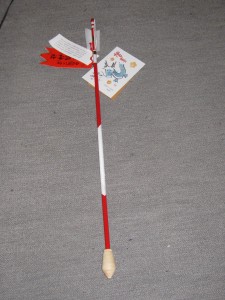
New Year fortune arrow to dispell negativity and help you hit your new year's target
Afterwards, by way of contrast, it’s fun to head straight for a shrine to pick up arrow and amulets for protection through the coming year. Following the contemplative pre-midnight atmosphere comes the a celebrative mood. Suddenly there are laughing voices, bright kimono, and gaudy lights. Stalls with aspiring yakuza sell candy floss and goldfish. Here all is jollity and smiles.
‘Akemashite omedeto’ (Congratulations on the New Year) is heard on every side, as people toss coins into offertory boxes over the heads of those in front. Hot saké is served spiced with ginger. Young women in kimono stand huddled over their fortune slips. With the blessing of the kami, the Year of the Dragon will surely turn out to be a good one.
Traditions and customs
New Year is a time of special food too – osechi ryori – beautifully displayed in lunch boxes as only the Japanese can do. The custom originated with the Heian aristocracy, for whom New Year’s Day was one of the five seasonal festivals. Since it was taboo to cook during the three day event, food was prepared beforehand.
The New Year food is a feast for the eyes as much as the stomach, full of symbols and auspicious elements. There’s tai fish to signify ‘medetai’ (congratulations), and black beans as a wish for good health (mame can mean bean and health). Broiled fish cake (kamaboko) is laid out in red and white layers, traditional colours of celebration and suggestive of the rising sun.
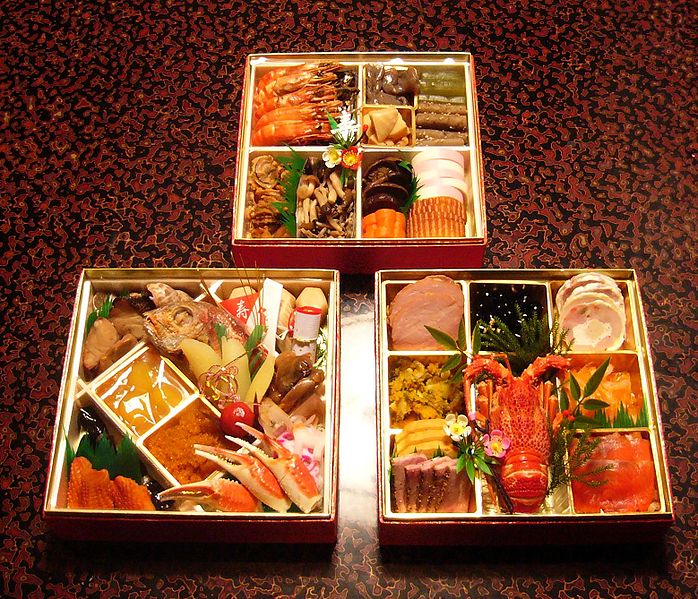
Traditional New Year's fare: a feast for the eyes (photo courtesy of Wikipedia)
Although the first shrine visit of the year (hatsumode) is supposed to be done within the first three days of the year, people pay respects for several days afterwards. Each year has its own auspicious direction, calculated by Chinese astrology, and one’s supposed to visit the shrine that lies in that direction though few actually follow the convention. It seems the majority of Japanese visit a shrine at some point, though attendance is difficult to interpret since some people may visit two or more shrines.
Numbers are eagerly collected, as if like GDP they reflect the well-being of the nation. Meiji Jingu tops the rankings, with just over three million visitors (who counts them, one wonders). In the Kansai region Fushimi Inari comes top with over two and a half million – one reason why I’ve never dared visit it at New Year, much as I love the place.
From now on the New Year is all about firstness and freshness. There’s the first dream of the year, which if it is about Mt Fuji, a hawk or an aubergine (!) is held to be particularly auspicious. There’s the first snowfall, the first sign of spring, and the year’s first haiku…
A new year dawning:
First snow on Hiei’s sacred peak
Forms a fresh sheet
One interesting custom is the giving of money to children, known as toshidama. Toshi is the year, and dama is its soul or spirit – so it’s as if one is renewing the spirit of the year through the gift. No doubt the money helps give extra vigour to the young!
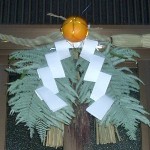
Kyoto-style New Year decoration (courtesy of japan.visitor)
Decorations
The traditional decoration is a length of shimenawa (sacred rice rope), festooned with ferns and the stem of a bitter orange, which is hung on the door. The fern is an evergreen and a symbol of the lifeforce, while the bitter orange is called daidai, which can also mean ‘generation to generation’. It shows the continuing vitality of the household.
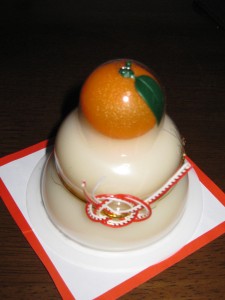
Commercially produced kagami mochi with daidai orange on top. The red and white wrapping signifies congratulations.
It’s customary at this time of year to have steamed rice cake (mochi). This was traditionally done by pounding it by hand and eating fresh, but nowadays supermarkets are filled with plastic packages containing two circular rice cakes on top of each other surmounted by a bitter orange.
Rice is a symbol of fertility, and the mochi cakes symbolise renewal of vigour through the eating of rice. Circular cakes are known as kagami mochi (mirror rice cakes). According to tradition, the sun-goddess Amaterasu presented her grandson with a circular mirror and told him to treat it as if it were her very self. It’s why mirrors are often used in shrines as the sacred ‘spirit-body’ of the kami. In this sense partaking of the round mochi is a kind of sacrament, the Japanese equivalent of communion. The rice in the mochi
The prime symbol of the New Year are the kadomatsu decorations seen in front of stores and large buildings. These can be grandiose affairs, and consist of three upright pieces of bamboo of differing length to represent the Taoist triad of heaven, earth and human.
Pine and plum branches complete the arrangment – pine not only as a symbol of constancy and vitality, but because the needles ward off evil spirits. The plum symbolises the promise of spring (before cherry blossom, the plum was Japan’s favourite tree for its early flowering amidst the austerity of winter.) Bamboo stands for persistence, a much admired trait among Japanese.

Kadomatsu (literally 'pine placed before the gate'), a traditional New Year decoration
The dragon is a magical creature, seen as a messenger from heaven. It moves freely in air and water, combining yin and yang, and it possesses something of all Five Chinese Elements. Unlike the monster of the Western tradition, the dragon is looked on as an auspicious creature of spiritual import, which is why it adorns the ceilings of Zen monasteries. In Shinto shrines, it’s usually seen at the water-basin dispensing the water through its mouth. Let us hope that the dragon spells for us too a magical year.
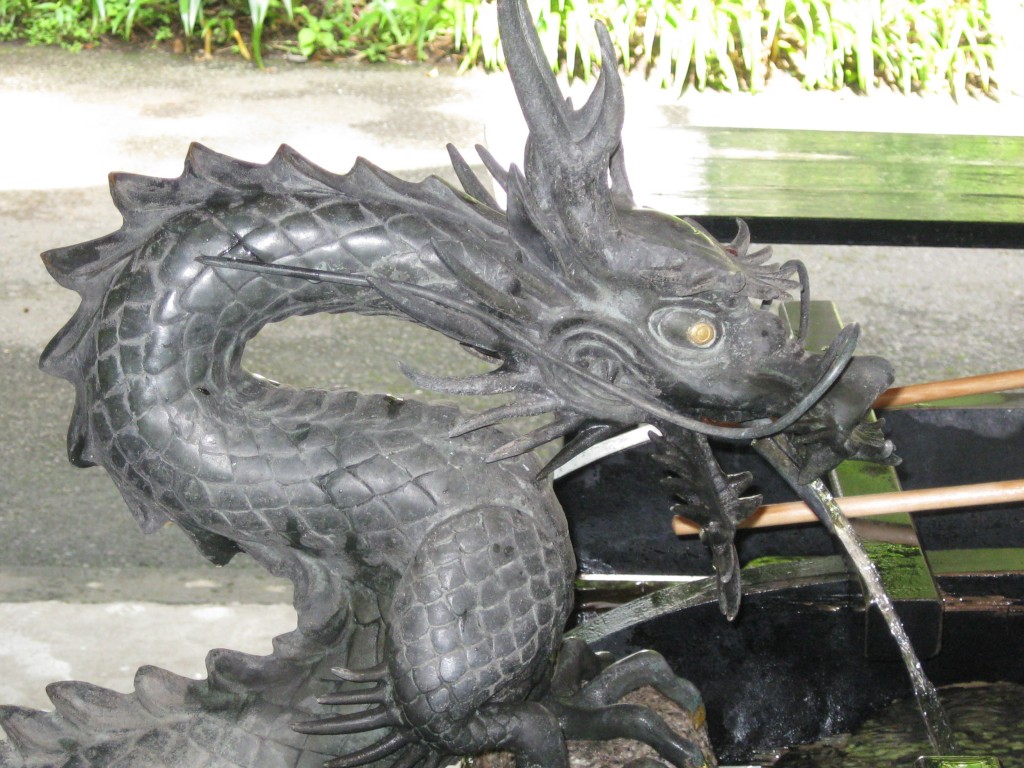
WITH BEST WISHES FOR A GOOD 2012 TO ONE AND ALL!!
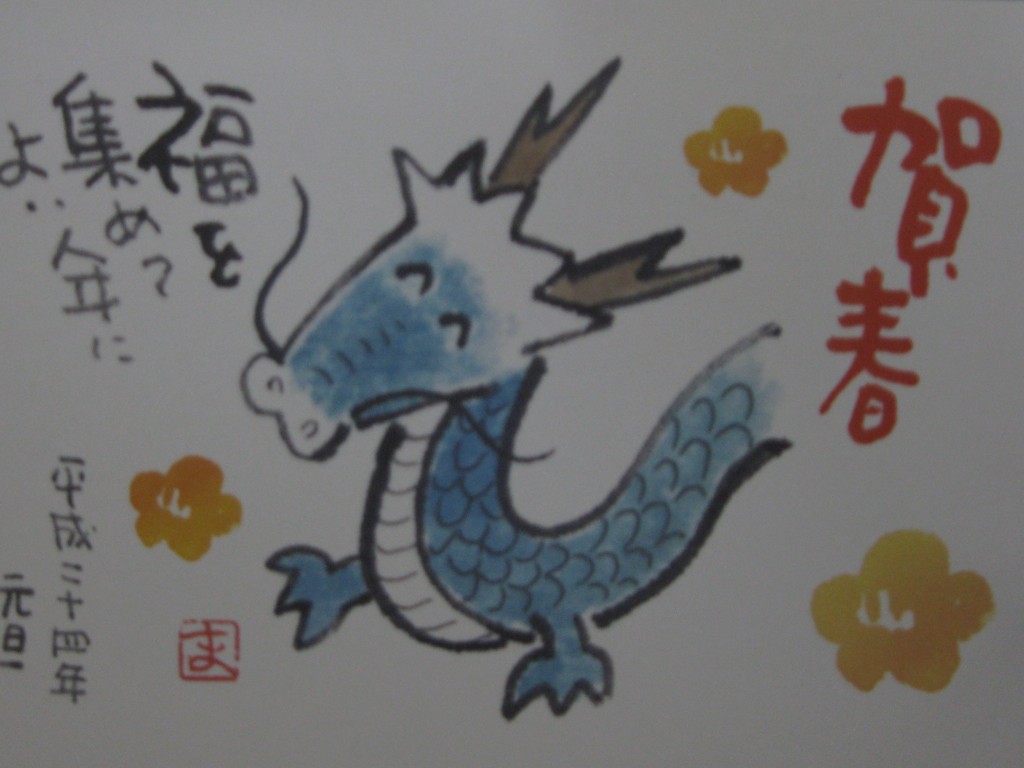

This is a wonderful blog! I came upon it only yesterday but since I am preparing for a trip to Kyoto next spring, I will read your informative posts regularly.
Happy New Year!